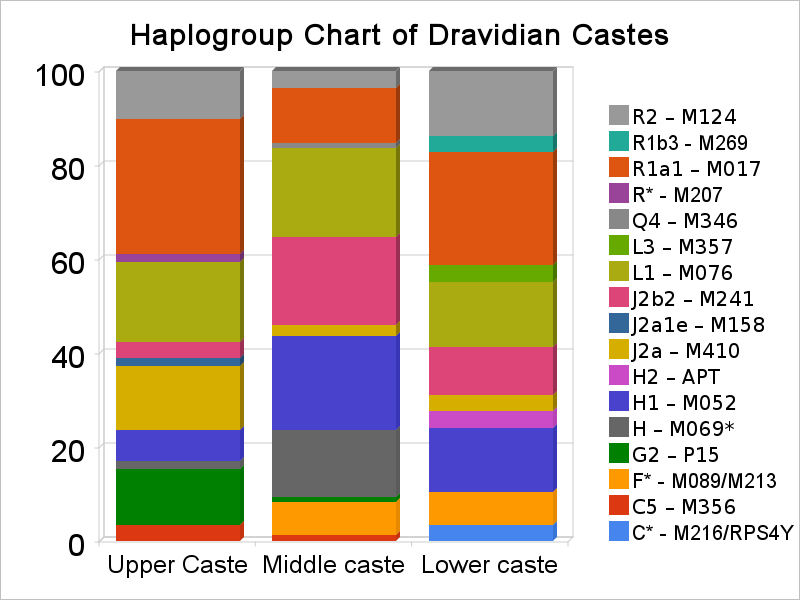S
sunkan
Guest
Y- Chromosome's and 'Gothra'
http://www.boloji. com/astro/ 00324.htm
How was this genetic work done? Geneticists used a scientific fact, that most of the male Y-chromosome is passed intact from father to son. Females do not carry the Y-chromosome. With modern advances in genetics, this fact has been used to trace paternal lineage, and resolve stories like Thomas Jefferson's.
Thomas Jefferson did not have surviving sons from his legal wife. But his paternal uncle's male lineage is in tact to present time. The genetic Y-chromosome of these persons (eight generations down from Thomas Jefferson's paternal uncle) living at present time was used as the reference. This was compared with intact male line persons from (Five generations down from) Sally Fleming living presently. The geneticists used polymorphic markers so that Y-chromosome can be distinguished by haplotypes. They found that Sally Fleming's son Eston's male line progeny had same haplotypes as Field Jefferson who was paternal uncle of Thomas Jefferson. Using other physical and living proximity factors, the geneticists have concluded with high probability that Eston Fleming was the son of Thomas Jefferson and Sally Fleming.
This class of human male lineage research is now very active and is being conducted in native populations of Wales, England, in Iceland and to establish uniqueness, paternity, historical lineage, medical issues and intellectual issues of heredity etc amongst various population groups.
http://www.boloji. com/astro/ 00324.htm
How was this genetic work done? Geneticists used a scientific fact, that most of the male Y-chromosome is passed intact from father to son. Females do not carry the Y-chromosome. With modern advances in genetics, this fact has been used to trace paternal lineage, and resolve stories like Thomas Jefferson's.
Thomas Jefferson did not have surviving sons from his legal wife. But his paternal uncle's male lineage is in tact to present time. The genetic Y-chromosome of these persons (eight generations down from Thomas Jefferson's paternal uncle) living at present time was used as the reference. This was compared with intact male line persons from (Five generations down from) Sally Fleming living presently. The geneticists used polymorphic markers so that Y-chromosome can be distinguished by haplotypes. They found that Sally Fleming's son Eston's male line progeny had same haplotypes as Field Jefferson who was paternal uncle of Thomas Jefferson. Using other physical and living proximity factors, the geneticists have concluded with high probability that Eston Fleming was the son of Thomas Jefferson and Sally Fleming.
This class of human male lineage research is now very active and is being conducted in native populations of Wales, England, in Iceland and to establish uniqueness, paternity, historical lineage, medical issues and intellectual issues of heredity etc amongst various population groups.
Does this not ring a bell amongst traditional Hindus who believe in 'gothra' identification carried down from Sanathana-dharma orthodoxy?.
'Gothra' is an identity carried by male lineage in India from time immemorial. Most people have gothra chain names traceable to Rig Vedic Rishis like 'Gowthama', 'Vasishta' 'Viswamithra' and to first sons of Vaivaswatha Manu like Angirasa & Bhrigu. Purana such as Vishnu Purana refer to individual identity through 'Gothra'. Listings of more than 250 Gothra chains have been explicitly listed. I have heard of instances of Muslims converted from Hinduism still keeping track of their 'Gothra'.
For example we know that Buddha, named Siddhartha was of 'Gowthama Gothra'. It means that his Y-chromosomes were probably from Rig-Vedic Rishi 'Gowthama Rahoogana'.
How did the people of 3000-4000 years ago realize that genetically there was transference of some unique characteristics only from father to son (in the form of Y-chromosomes) ? In recent past when it was fashionable to condemn all Indian traditional systems as of no value, non-believers have referred to 'Gothra' as archaic, unscientific, irrelevant and male chauvinistic!
Modern DNA & genetic research has confirmed male line Y-chromosomal transference, through 8 generations in case of Thomas Jefferson. 'Gothra' in essence really stands for Y-chromosomal identity.
Nearly 2500 years have passed since death of Buddha, but many 'Gowthama Gothra' individuals exist now also. They can claim genetic relation to Buddha. Typically 4 generations occur in 100 years and in 2500 years nearly 100 generations are complete. Other 'Gothra' chains may have run 100-200 generations from Vedic period if male lineage did continue unbroken. Do Y-chromosomes remain intact after, say 100 generations of unbroken male issues? Genetic mutations may or may not have changed some Y-chromosomes.
This appears to be a very interesting field of research for future to see if persons of same 'Gothra' in the present generations have common and unique Y-chromosomal features.
For example we know that Buddha, named Siddhartha was of 'Gowthama Gothra'. It means that his Y-chromosomes were probably from Rig-Vedic Rishi 'Gowthama Rahoogana'.
How did the people of 3000-4000 years ago realize that genetically there was transference of some unique characteristics only from father to son (in the form of Y-chromosomes) ? In recent past when it was fashionable to condemn all Indian traditional systems as of no value, non-believers have referred to 'Gothra' as archaic, unscientific, irrelevant and male chauvinistic!
Modern DNA & genetic research has confirmed male line Y-chromosomal transference, through 8 generations in case of Thomas Jefferson. 'Gothra' in essence really stands for Y-chromosomal identity.
Nearly 2500 years have passed since death of Buddha, but many 'Gowthama Gothra' individuals exist now also. They can claim genetic relation to Buddha. Typically 4 generations occur in 100 years and in 2500 years nearly 100 generations are complete. Other 'Gothra' chains may have run 100-200 generations from Vedic period if male lineage did continue unbroken. Do Y-chromosomes remain intact after, say 100 generations of unbroken male issues? Genetic mutations may or may not have changed some Y-chromosomes.
This appears to be a very interesting field of research for future to see if persons of same 'Gothra' in the present generations have common and unique Y-chromosomal features.

